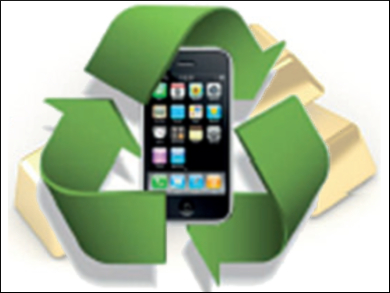Recovering Metals from Electronic Waste
The recovery of gold and other noble metals from electronic waste, in particular, discarded mobile phones, has enormous potential but is still underdeveloped. British and American scientists have now identified a simple and nontoxic compound that is able to extract gold selectively from a mixture of metals that are usually present in such electronic waste. How this selective binding could be used in a convenient protocol for efficient gold recovery is described in the journal Angewandte Chemie.
Compared to their usual contents in primary mining deposits, gold and other noble metals are vastly enriched in commercial electrical and electronic equipment, especially in mobile phones, computers, and tablets. For their efficient recovery from discarded material, they need to be extracted and isolated in an as low-cost and environmentally friendly a manner as possible. Addressing the issue that the chemistry of solvent extraction of gold is still poorly understood, Jason Love, University of Edinburgh, UK, and colleagues have developed a rather simple chemical compound that binds gold efficiently under the conditions of noble metal leaching from electronic waste.
Simple Extraction Method
The scientists discovered that a simple primary amide could readily form stable complexes with the gold species leached from the metal mixture. Using spectroscopic and computational analyses, they defined the extracted gold species as a mixture of aggregates composed of the negatively charged gold chloride complex ion bound by the positively charged amide ligand. Their knowledge could be very helpful in designing efficient extraction and recovery processes, as the researchers wrote: “We anticipate that the fundamental chemical understanding gained here is integral to the development of metal recovery processes.”
To extract the gold species from the hydrochloric acid leaching solution, they added the primary amide to an aromatic hydrocarbon solvent. This extraction proceeded far more efficiently than the extraction with commercial reagents. Furthermore, the back transfer into the aqueous phase was also successful, without the need for additional stripping reagents. The two-phase extraction could be understood as a process of selective encapsulation and release. The authors concluded that the mechanism “draws parallels with the developments of encapsulation complexes in which intricate entities are assembled in solution.” Their findings could pave the way for a simple and efficient, low-cost, and environmentally friendly recovery process of gold from waste.
- A Simple Primary Amide for the Selective Recovery of Gold from Secondary Resources,
Euan D. Doidge, Innis Carson, Peter A. Tasker, Ross J. Ellis, Carole A. Morrison, Jason B. Love,
Angew. Chem. Int. Ed. 2016.
DOI: 10.1002/anie.201606113




